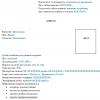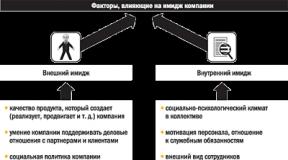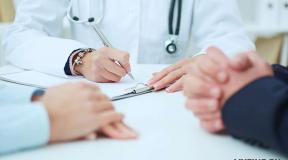Sharp pain during menstruation what to do. Pain during menstruation. Pain relief drugs
Normal periods come regularly and last 3-5 days. These days, a woman quickly gets tired, feels unwell. However, this does not cause too much discomfort, does not interfere with the usual way of life. However, some people experience severe abdominal pain. Sometimes she is so painful that the woman is forced to abandon all business, stay at home, take pain pills. Such pain during menstruation is a sign of pathology. Diseases and hormonal disorders can be the cause. You cannot endure and hope that the malaise will go away on its own. I have to go to the doctor.
Content:
When menstrual pain is considered a pathology
The lining of the uterus (endometrium) is regularly renewed, resulting in menstruation. Removal of dead epithelium from the uterus is carried out by contraction of its muscles. In this case, compression of nerve endings and compression of blood vessels occurs, which causes the appearance of painful sensations in the lower abdomen. The pain radiates to the sacrum and lower back. They usually appear on the eve of menstruation and in the first 2 days after their arrival.
Painful menstruation (dysmenorrhea) is a pathology. In addition to pain in the lower abdomen and back, concomitant ailments appear varying degrees severity. If a woman's cycle is regular, the nature of her period is normal, then the unpleasant symptoms quickly pass without causing her any special torment. Severe cases require serious treatment.
Types of dysmenorrhea
There are two types of dysmenorrhea:
- Primary (functional), not associated with any disease. Usually, painful menstruation becomes 1.5-2 years after the onset of puberty, when the cycle returns to normal, ovulation occurs regularly. Often, the pain during menstruation is significantly weakened after the first birth.
- Secondary (acquired) associated with pathological changes in the genitals and various diseases... It occurs most often in women over 30 years of age. Usually accompanied by vegetative-vascular disorders (dizziness, excessive sweating, and others), as well as tachycardia and cardiac arrhythmia.
If over the years the intensity of pain during menstruation remains constant, then such dysmenorrhea is called compensated. If pain during menstruation becomes stronger every year, then it is called decompensated.
Dysmenorrhea degree
There are 4 degrees of dysmenorrhea, which differ in the intensity of pain.
0 degree. The abdominal pain is mild, and pain relievers are not required.
1 degree. Painful sensations moderate, quite tolerant. Natural accompanying symptoms are mild depression, headache, and indigestion. The malaise can be completely eliminated by taking an anesthetic drug.

2nd degree. Pain during menstruation is severe, accompanied by symptoms such as nausea, dizziness, chills, general weakness, migraine, irritability. The duration of the ailments increases. Pain relievers and sedatives can help you feel better.
3 degree. Severe abdominal pain occurs in a woman 2-3 days before the onset of menstruation, continues until its end. At the same time, the temperature rises, the head hurts very much (until vomiting), tachycardia and pain in the heart occur. Fainting is possible. The woman is completely inoperative. It is not possible to improve the condition by conventional means.
Addition: Pain during menstruation may differ in nature (cramping, pulling, aching, stabbing), give to the lower back, hips.
Causes of Painful Menstruation
Functional pain during menstruation can occur as a result of the pathological location of the uterus, the formation of adhesions and scars after an abortion, increased sensitivity of the woman's body to the changes occurring in it, emotional excitability. An important role is played by heredity. The onset of pain can provoke vitamin deficiency and a lack of magnesium and calcium in the body. A sedentary lifestyle is also the cause of progressive dysmenorrhea. Contributes to the onset of pain during menstruation and such a factor as hormonal disorders in the body. An excess of the hormone prostaglandin causes an increase in uterine contractions, narrowing blood vessels.
The appearance of primary dysmenorrhea is facilitated by the use of an intrauterine device. Secondary dysmenorrhea can appear as a result of pathologies such as endometriosis, uterine fibroids, ectopic pregnancy, and pelvic inflammatory disease. Severe pain during menstruation appears due to the formation of polyps and cysts in the uterus.
Video: What are the causes of painful periods
How to reduce pain during menstruation
If the pain is moderate, the cycle is regular, menstruation is normal in volume and duration, then with the help of some techniques it is possible to weaken painful sensations.
Recommendation: In case of severe pain, it is recommended to visit a doctor and make sure that there are no diseases that are asymptomatic. In some cases, chronic inflammatory diseases and even tumors may not manifest themselves in any way. A pain symptom may be the only signal of trouble.
If, after a gynecological examination, a woman does not have any diseases, then at home, the condition can be alleviated in the following ways:
- Massage your abdominal muscles in a clockwise direction to relieve tension and cramps. It is also good to massage the lower back.
- Take a warm shower to relax your muscles and dilate your blood vessels.
- Lie on your side with your legs tucked into your stomach (fetal position).
- Take no-shpa to eliminate spasm in the uterus, ketonal or ibuprofen (have a strong analgesic effect), valerian (as a sedative).
- Do light physical exercise (bending, rotating the body). Good help from pain during menstruation yoga.
- Apply compresses during menstruation with sea salt on the lower abdomen. Before and after menstruation, it is useful to take a relaxing short (15-20 minutes) bath with the addition of such salt.
- Drink a soothing chamomile and mint tea (add 1-2 teaspoons of honey to 1 glass of tea). It is useful to take an infusion of parsley, strawberries.
- If there is no allergy, you can rub into the skin in the area of the sacrum and lower abdomen essential oil... The procedure is carried out 2 times a day 2 days before menstruation and in the first 2-3 days after their start. It helps to relieve severe pain during menstruation with a mixture containing 50 ml of St. John's wort oil, 5 drops of yarrow and sage oil.
- In case of pain and profuse bleeding, ice should be applied to the lower abdomen for 15 minutes (on top of clothing, put it in a bag).
Swimming is recommended. During swimming, muscles relax, nervous tension is relieved. In the body, endorphins are intensively produced (the so-called hormones of joy, analgesic substances).
Video: Exercises against pain during menstruation
When to see a doctor
Obvious signs of serious pathologies are most often severe pain lasting a long time (more than 2 days). Moreover, the painful sensations are so strong that the woman is forced to postpone all her affairs and stay at home. Abdominal pain is accompanied by diarrhea, nausea and vomiting. Dizziness, headache, stitching pains in the abdomen may be signs of excessive blood loss and anemia.
Severe cramping abdominal pain occurs with an ectopic pregnancy. In this case, the woman needs an urgent operation.
When pain medications and no-shpa do not help, the pain and volume of discharge increase, a doctor's consultation is simply necessary. If severe pains appear during menstruation suddenly against the background of a violation of the cycle, weight loss, this may be a sign of a tumor. It is urgent to be examined by a gynecologist.
Drugs prescribed for dysmenorrhea
Menstrual pain affects 90% of women between the ages of 18 and 35. Such pains are often intense, so the timely use of an effective analgesic helps patients restore the rhythm of life and completely eliminate menstrual pain.
Dialrapid is a fast-acting analgesic that relieves pain of any intensity. Potassium bicarbonate acts as a pH buffer, providing the drug with complete dissolution in water, and subsequently creating a microenvironment around active substance- diclofenac potassium. It is this microenvironment that promotes accelerated absorption and helps the drug to be completely absorbed by the body. Dialrapid shows a pronounced effect in the first 5 minutes after application. The powder is absorbed by the body almost as quickly as an injection, and, unlike tablet analogs, has a high peak plasma concentration 1.
To eliminate pathological pain during menstruation, the doctor prescribes, along with antispasmodic drugs, non-steroidal anti-inflammatory drugs. They are able to suppress the production of prostaglandins, thereby reducing uterine contractility.
For the treatment of dysmenorrhea are widely used oral contraceptives- hormonal low-dose drugs that prevent the formation of excess prostaglandins. Also used are herbal preparations based on phytoestrogens, which help to improve hormonal levels, as well as homeopathic remedies of non-hormonal action (menalgin). Gradually accumulating in the body, they help to regulate the menstrual cycle, reduce pain and improve condition. nervous system.

Complex preparations containing vitamins, calcium, iron, magnesium, as well as plant extracts (for example, a time factor) are prescribed. It is recommended to start taking medication in advance, before the start of your period. Then, by the time they occur, the required dose is accumulated in the body, the drug acts more efficiently.
Methods of physiotherapy - UHF and electrophoresis help to reduce pain during menstruation. In this case, the procedure is carried out in advance. Before the onset of menstruation, special solutions (novocaine, sodium bromide) are applied to the abdomen and exposure to ultrasound or electrical impulses is performed. Warming up and anesthesia occurs.
Prevention of dysmenorrhea
In order for menstruation to be less painful, it is recommended to stop drinking alcohol on critical days, avoid stress, not catch colds, move more, and do yoga. It is necessary to limit the use these days of sugar, foods that cause bloating. It is beneficial to eat chocolate, which stimulates the production of endorphins, as well as foods containing calcium and magnesium.
Video: Yoga during menstruation
1. There are contraindications. It is necessary to read the instructions or consult a specialist.
In most cases, menstrual pain is easy to explain. If pregnancy has not occurred, the endometrium (the lining of the uterus) is torn away from the walls of the uterus, while prostaglandins are released, which contributes to a better release of the remnants of the uterine lining to the outside. If there are a lot of prostaglandins, the muscles contract more actively, which causes menstrual pain.
Specialists for painful periods have their own name - dysmenorrhea (earlier it was called algodismenorrhea). In addition, doctors divide it into primary and secondary.
- Primary dysmenorrhea is characteristic of young girls and women (between the ages of about 14 and 25) and is characterized by contractile activity of the uterus. In addition to the characteristic pain in the lower abdomen, symptoms of primary dysmenorrhea can include nausea, headaches, and upset stools. They usually appear the day before and a couple of days after the onset of menstruation. Dysmenorrhea is successfully treated and if painful menstruation is troubling, it is better to see a doctor who will prescribe treatment.
- Secondary dysmenorrhea is usually associated with organic changes in the pelvic organs (for example, endometriosis, chronic inflammatory processes with the formation of adhesions). In this case, pick up correct treatment only your attending gynecologist can.
Causes of menstrual pain that are not associated with diseases of the female reproductive system include:
- intrauterine device
- lack of physical activity
- deficiency of magnesium and calcium in the body
- improper nutrition
- stress and lack of sleep
- low pain threshold
How to get rid of menstrual pain
If the pain before or during menstruation quickly passes and does not cause you any special inconvenience, you practically do not pay attention to the onset of menstruation and lead a normal life, then you just need to take care of yourself, avoiding excessive physical exertion on these days. But if the first day of your period turns into a real nightmare for you, it is worth taking action.
How to reduce pain during menstruation
Pain medications
The easiest and most popular way is to take a pill that relieves pain and cramps. Just be sure to check with your doctor which drug is right for you. But don't make taking painkillers a habit. If you cannot live without pills every month and take them several times a day, this is a wake-up call, meaning that you need to see a doctor immediately.
Oral contraceptives
Birth control pills contain hormones that suppress ovulation. No ovulation - no painful periods. Among other things, they will relieve you of the manifestations of PMS (premenstrual syndrome). But keep in mind that you need to select such pills individually and only your gynecologist can do this based on the results of examinations and analyzes.
Physical exercise
Some women mistakenly believe that sports are contraindicated during menstruation, although in reality the opposite is true. Exercise ensures good blood circulation in the muscles and makes them more elastic. The uterus is made up of several types of muscles, so regular exercise and good constant stretching make it much easier to cope with the pain during menstruation caused by uterine contraction.
So if you do not have special prescriptions from your doctors, try doing light exercises:
- Stand straight with your feet shoulder-width apart and do 15–20 squats. Be sure to keep the weight on your heels and keep your back straight.
- Sit in a Turkish position and slowly begin to bring your knees in and out. Repeat 15-20 times.
- Get on all fours, arch your back like a cat, and then return to the starting position. Repeat 15-20 times.
But it is better to refuse serious power loads in the first days of menstruation.
Swimming
Swimming is worth highlighting separately. It is the safest and least traumatic sport to relieve pain. It helps relax muscles and relieve tension. Just remember to use a tampon while swimming, and change it right after the pool. Tampax tampons are ideal for this. Their plastic Compak applicator fits easily in your hand so you can quickly and discreetly go and change your tampon.
Taking vitamins
Vitamin B6 and magnesium are friends and main helpers of women suffering from menstrual cramps. Taking these vitamins and minerals will help reduce discomfort. In addition, today there are many vitamin complexes that can ease the course of menstruation. But it is best to pick them up with a doctor.
Heat
Take a warm, comfortable shower or place a warm (!) Heating pad on your lower abdomen to relieve pain. And if there is no special heating pad, you can pour warm water into ordinary plastic bottle... This method is best for relieving menstrual pain before bed, as it’s best to go straight to a warm bed after showering.
Herbal teas, decoctions and infusions
Chamomile or peppermint tea can also help relax your abdominal muscles and reduce menstrual pain. Herbal infusions are also well suited - nettle, horsetail, wild strawberries and calendula.
Embryo pose
Lie down, or rather get some sleep in the fetal position. To do this, lie on the floor and pull your legs up to your stomach. This position will help you relax and relieve pain.
Balanced diet
On the eve and during menstruation, doctors recommend reducing the consumption of coffee, strong tea, as well as fried and spicy. But foods rich in calcium should be eaten more actively. Include more cottage cheese, milk porridge, fish, cheese and bananas in your diet. By the way, bananas, among other things, will also help improve your mood, which will definitely not hurt in the first days of your period.
Massage of the abdomen and lower back
- A lower back massage can help relieve cramps and soothe pain. Ideally, a loved one should do it for you. But if at the right moment such a person is not around, you can make him yourself yourself. Put a tennis ball in two bags or socks and lie on them with your lower back (the balls should be on either side of the spine at the level of the lower ribs). Gently roll the balls, massaging the muscles.
- Massaging your abdomen will help relieve tension in your abdominal area. To do this, massage your stomach with a warm hand in a clockwise circular motion.
Prevention of pain during menstruation
To keep your menstrual pain from bothering you:
- Lead an active lifestyle and exercise. According to statistics, athletes are much less likely to complain of pain during menstruation. Moreover, the sport can be anything - from yoga, Pilates and swimming to martial arts and dancing.
- Get more fresh air and get enough sleep.
- Include in the diet foods rich in calcium (cottage cheese, cheese, seafood) and magnesium (buckwheat, parsley, spinach, dark chocolate).
- Try to eat less spicy and fried foods and avoid coffee and strong tea.
- Give up bad habits.
- Do not overcool, avoid stressful situations. Visit your gynecologist every six months, even if nothing bothers you. Any disease is much easier to prevent than to cure. Not to mention that many processes in female body can be asymptomatic for a long time.
In what cases you should immediately consult a doctor:
- The pain is so strong that you have to take sick leave and not get out of bed all day.
- The pain lasts more than two days.
- Menstrual pains began to torment you recently, although in the past, menstruation was painless.
- Your periods are heavier than usual or last much longer.
- You are taking oral contraceptives, and severe pain still bothers you.
- Pain medications do not help you.
In all these cases, you should not self-medicate or heroically endure unpleasant sensations. It is better to go to the gynecologist as soon as possible in order to establish and eliminate the cause of these symptoms and quickly return to the usual way of life.
Pain and discomfort in the lower abdomen is a common condition for many women during menstrual cycle... Scientifically, this phenomenon is designated by the term "algomenorrhea" (dysmenorrhea).
Statistics show that about 70-80% of women suffer from pain during menstruation. To eliminate all sorts of unpleasant symptoms, you first need to understand the etymology of pain.
Having found out the causes of pain, you can understand: this is a common phenomenon inherent in the natural processes in a woman's body, or a reason to immediately consult a doctor and how to reduce pain during menstruation.
Causes of painful periods
During menstruation, the tissues of the uterus produce prostaglandin, which causes it to contract.
The severity of painful sensations depends on the level of this hormone. Doctors distinguish two groups of causes of monthly pain.
Primary dysmenorrhea
Inherent in women under 35 and adolescents. With primary algomenorrhea, hormonal changes occur associated with an increase in the amount of prostaglandin.
In simple words, the causes of cramping pains and vasospasm in hormonal disorders and anxiety, stress. At the same time, it is observed that adolescent girls experience especially severe pain.
Symptoms of primary dysmenorrhea:
- Headache.
- Stool disorder.
- Soreness of the same intensity throughout the cycle.
In addition to pulling pains in the lower abdomen and in the lumbar zone, reactions such as nausea, vomiting, and fainting may occur. In the absence of serious problems, discomfort disappears with age, as well as after childbirth.
Secondary dysmenorrhea
 Women over 35 are affected.
Women over 35 are affected.
Secondary algomenorrhea is a sign of inflammatory diseases, pathologies of the pelvic organs.
It can be associated with the development of fibromatous nodes, pelvic neuritis, endometriosis, fibroids, polyps in the uterus, as well as with the consequences of gynecological and abdominal operations (abdominal adhesions).
An intrauterine device can also cause severe pain during menstruation. Bleeding and pain in this case are more intense. A visit to a gynecologist is the first thing to do in such situations, which will already tell you how to remove abdominal pain during menstruation.
Causes of painful periods, not related to problems of the reproductive system:
- Violation of the balance of the female genital organs, excessive activity of the thyroid gland.
- Intrauterine device.
- High threshold of sensitivity to changes in the body.
- Instability of the nervous system.
- Pain due to abortion or childbirth.
- Incorrect position of the uterus.
- Hereditary predisposition.
- Deficiency of magnesium, calcium.
- Unbalanced diet.
Women suffering from secondary dysmenorrhea have low libido, they feel dissatisfaction with their sexual life, a tendency to depression, depression, sometimes even psychological abnormalities can be observed.
At the same time, cure for concomitant algomenorrhea diseases contributes to the almost complete cessation of pain during critical days. But with younger and healthier women outwardly, the situation is more complicated.
With increased discomfort, profuse bleeding, the appearance of nausea, migraine, you should immediately contact a specialist, take the recommended tests, undergo an ultrasound examination, which will help you figure out how to relieve pain during painful periods.
Attention!
With primary algomenorrhea, it is important to maintain the first pregnancy.
The first medical abortion (consequences) in a woman with painful menstruation can provoke the development of further infertility and aggravate soreness during the course of menstruation.
After pregnancy, in most cases, pain during menstruation decreases.
Pain relief methods
 There are many ways to relieve pain during your period that can have a tangible effect.
There are many ways to relieve pain during your period that can have a tangible effect.
They can also be used at home (taking into account the existing contraindications).
Let's take a closer look at each of the categories that answer how to reduce or alleviate pain during menstruation without pills and at home.
Medications
This method is suitable for those who are an adherent of traditional medical technologies in treatment, deciding the question of how to relieve pain during menstruation if the lower abdomen hurts.
- Over-the-counter medicines... In this category - NSAIDs, that is, non-steroidal anti-inflammatory drugs, as an example, ibuprofen.
- Antispasmodics... These include "No-shpa", "Ketonal", "Spazmalgon", "Analgin".
- Sedative... Pain caused by stress, overexcitation of the nervous system can be dealt with by a common sedative (for example, valerian).
Before using medication, consult your doctor!
Before using medicines to relieve abdominal pain, you must consult a doctor or independently study all its aspects according to the instructions. Another category drug treatment- oral contraceptives (birth control pills).
In this case, the medication is taken strictly as prescribed by a specialist. Contraceptives contain hormones that restore hormonal levels in a woman's body and thus relieve menstrual pain.
The birth control pill is used daily. They are affordable and sold in almost all pharmacies.
Contraceptive methods for eliminating pain in the lower abdomen also include contraceptive patches, a contraceptive vaginal ring, hormonal injections, and an intrauterine device. Before using these remedies to eliminate pain, you should consult your doctor.
Folk recipes:
- Raspberry leaves- Pour 3 teaspoons of leaves with 1 glass of boiling water, insist for 15 minutes, take in small sips throughout the day.
- Elecampane root- 1 teaspoon is poured with a glass of boiling water, insisted for 1 hour, take 1 tablespoon 3 r / day.
- Horsetail- for the preparation of the infusion, 1 tbsp. pour a spoonful of 300 ml of boiling water, insist for one hour, use 50 mg every hour, increase the interval of admission as the pain subsides.
ethnoscience
 Option for those interested in home treatments.
Option for those interested in home treatments.
Alternative ways to relieve menstrual pain without pills include:
- Heat... In some cases, ordinary heat is even more effective than medication. A heating pad or thermoplastic applied to the lower abdomen (for no more than 10-15 minutes) will help relax the muscles and eliminate unpleasant symptoms.
Adhesive plasters are very comfortable and keep you warm for a long time. An alternative option is also a warm bath, shower, and swimming in the pool.
The water will soothe the pain. After water procedures, it is recommended to put on warm clothes and lie down for a couple of hours. - Behavioral or imaginative intervention... Relaxation, positive attitude, breathing exercises have a positive effect on the emotional state. These techniques can help you take your mind off the pain.
This also includes doing what you love: chatting with friends on the Internet, playing computer games, reading books, magazines, watching an interesting movie. - Massage... Light stroking of the abdomen (clockwise) to reduce discomfort, relieve spasms. In this case, you should lie down and put some object under your feet so that they are in an elevated position.
Do not press very hard on your belly and lower back, this will relax your muscles and eliminate pain. - Herbs... Hot tea made from lemon balm, raspberry, chamomile, cherry, nettle leaves, as well as other warm infusions will help with painful periods.
In the absence of allergies, you can optionally add honey to the decoctions. To improve your well-being, it is recommended to consume as much liquid as possible during critical days. - Other techniques... In this group, methods of relieving monthly pain, available at home. Taking the right position will help reduce discomfort.
To do this, you need to lie on your side and curl up, that is, take the pose of an embryo. This condition will allow you to slightly relieve pain and get rid of the discomfort that occurs during blood flow to the genitals.
Another way to relieve pain is "belly breathing". The procedure must be done in the following sequence: put a book on your stomach, take a slow breath, while lifting the book with your lower abdomen.
Having raised it to a certain height, pause in this state. Repeat the exercise for 2-5 minutes.
Nutrition
Pain during critical days is often caused by a woman's unhealthy diet. There are several rules, if followed, you can significantly reduce the possibility of discomfort:
- Limiting the amount of dairy, flour, meat products in the diet. Recommended before menstruation and throughout the cycle.
- Get plenty of vegetable juices. Green vegetables and berries contain antioxidants that fight inflammation.
- Reception in the recommended amount of vitamin and mineral complexes. They should contain vitamins A, E, B vitamins, magnesium, calcium, iron. These drugs are prescribed after passing the appropriate tests.
- Limiting tobacco use, alcoholic beverages... Alcoholic beverages can cause fluid retention and bloating. Nicotine causes vasoconstriction, which can reduce the flow of blood into the uterus and increase painful spasms.
- The day before menstruation, make a fasting day.
Physical exercise
 Moderate exercise stress for pain in the lower back and abdomen, it will help relieve discomfort. Leisurely outdoor walks will also be helpful.
Moderate exercise stress for pain in the lower back and abdomen, it will help relieve discomfort. Leisurely outdoor walks will also be helpful.
A set of exercises to reduce soreness during menstruation:
- Starting position: lying on your back. Raise your legs at an angle of about 90 degrees. Stay in this position for a few minutes.
- Starting position: lying on your stomach. Resting on the floor with your hands, slowly raise your chest, bend as much as possible.
- Starting position: lying on your back. Bend your legs at the knees. Bend your stomach up, leaning on your feet. Go down smoothly.
Physical activity leads to the production of endorphins in the body, i.e. natural pain relievers. Walking, jogging, exercising in the gym, cycling, swimming - all this set of exercises will help in one way or another in case of a problem.
The use of herbal decoctions during menstruation, adherence to a diet along with exercise can give an even more pronounced effect. Pilates and yoga are also well-established as pain relievers for muscle tone.
Prevention of painful sensations
Healthy lifestyle - the best way prevention of various diseases, including pain in the lower abdomen during menstruation.
Take a holistic approach to pain management!
- Refusal from harmful, aggravating habits, such as smoking, alcohol, drugs.
- Limiting the use of spicy and spicy foods, coffee.
- Regular sex life. On average, up to 3-4 times a week.
- Positive emotions, avoidance of stress and hypothermia.
- Regular physical activity (dancing, running, yoga, swimming).
For persistent, persistent pain during menstruation, see your doctor..
You can find additional information on this topic in the section.
Most women know firsthand about the signs of approaching menstruation, manifested in the form of irritability, mood swings, painful sensations in the chest, lower back, side and abdomen. What are the causes of severe pain during menstruation? Why is the pain so much stronger on day 1? This will be clarified in this article.
Pain during menstruation is so strong that a woman has a violation of her usual way of life. This condition is called dysmenorrhea.
Dysmenorrhea - irregularities in the menstrual cycle, which are accompanied by pain. And neurophysiologists include in this concept disorders in the neurovegetative, endocrine and mental systems. The main symptom of all of them is one - pain on the eve of menstruation.
According to statistics, dysmenorrhea is widespread among women and in terms of frequency of occurrence varies within 43-90%. Someone tolerates it very hard, someone lighter, and someone without any problems at all. It all depends on the character, social status and working conditions of the woman.
As for the types of dysmenorrhea, most often it is acquired, that is, pathology formed due to violations in the work of the female genital organs. But there are also cases when dysmenorrhea occurs at a young age without the presence of pathology. In this regard, this disease is divided into two types: primary and secondary.
Dysmenorrhea primary is also called idiopathic. It occurs in the absence of diseases of the genital organs, both after the first menstruation, and after many years of the menstrual cycle. Pain on initial stage are short-term, they are aching and do not bother the woman much. But after a few years, the pains get worse and last for several days.
There is a tendency that women who complain of pain during menstruation are diagnosed with vegetative-vascular dystonia, myopia, prolapse. mitral valve, flat feet and scaliosis.
Dysmenorrhea secondary is the result of a woman having various organic diseases... Pain syndrome is caused by a violation of the uterine blood supply, stretching of the walls of the uterus and a spasm of its muscles.
Types of pain on the first day of menstruation
Only 25% of women do not experience pain during menstruation; for the remaining 75%, painful sensations during critical days are constant companions. Pain usually begins a day or two before the onset of menstruation, or on its first day. These unpleasant sensations can be considered normal only if they do not cause a woman strong discomfort, do not deprive her of the ability to get out of bed and go about her daily activities.
Pain appears on the first day of critical days in the lower abdomen and gradually fades away by the second or third day of menstruation. The pain can be aching, twitching, or paroxysmal and radiate to the lower back, bladder or rectum.
Along with this, many women experience apathy, depression, irritability, lack of appetite, nausea, and in rare cases, vomiting, excessive sweating, breast tenderness, constipation or diarrhea.
Pain on the first day of menstruation is associated with hormonal changes occurring in the female body during this period. Since the egg has not been fertilized, the lining of the uterus begins to renew itself: to remove the old endometrium and build up a new one. Hormones to get rid of dying endometrium cause muscle contractions in the uterus, which makes women feel painful. But pain can be associated with dysmenorrhea, the types of which are mentioned above.
If on the first day of menstruation the pain is not particularly strong, then in order to make the feeling of discomfort less, it is enough to follow only these simple rules:
- drink plenty of fluids;
- perform physical activity at a moderate pace;
- take a slightly warm shower (but do not sit in the bath);
- take some pain medication.
But if the pain is so severe that the woman cannot get out of bed, it is better to consult a gynecologist to rule out serious health problems.
Migraine before and after menstruation
Migraines before and after menstruation are common. The main reason for its occurrence is jumps in the sex hormones estrogen and progesterone, and the predisposing factors of this condition are hereditary predisposition and a tendency to increased platelet adhesion.
Migraine can be observed not only before and after menstruation, but also during menopause, during pregnancy and lactation. Each of these conditions provokes hormonal surges, which is why severe headaches begin.
Very often migraines occur in young girls during puberty, and disappear as hormones return to normal. But migraines during menstruation also occur in women for a longer time: in some they disappear after they give birth, while in others they last until the end of their lives.
 Migraine, which begins before menstruation, is associated with them and is called menstrual. During this period, intense headaches occur in the vast majority of women and their duration varies from 4 to 72 hours. A symptom of an onset migraine is the localization of throbbing pain on one side. If you ask a woman to rate headache on a ten-point scale, then their assessments will be in the range of 5-9 points.
Migraine, which begins before menstruation, is associated with them and is called menstrual. During this period, intense headaches occur in the vast majority of women and their duration varies from 4 to 72 hours. A symptom of an onset migraine is the localization of throbbing pain on one side. If you ask a woman to rate headache on a ten-point scale, then their assessments will be in the range of 5-9 points.
Migraine attacks before the onset of menstruation are often combined with pulling pains in the lower abdomen.
Lower abdominal pain
The pain in itself causes discomfort, but how to live if the pain in the lower abdomen occurs in a woman every month before the onset of menstruation? You need to understand where it comes from in order to take some action.
If the pain is mild, but pulling, and is concentrated only in the lower abdomen, the woman should not be alarmed. They mean the approach of menstruation. In addition to these pains, a woman may feel painful sensations in the chest. It is good if the pain is not prolonged and admission antispasmodic drugs not required. It is worse if it lasts from 1 to 3 days, and the woman cannot do without pain relievers, which signals dysmenorrhea and the help of a gynecologist is needed.
Pulling back pain
Many women complain of lower back pain during critical days. There is even a concept of radiating pain among doctors. But do not worry too much about the pulling lumbar pain, since in our time it can be easily eliminated drugs or massage.
The reasons for pulling back pain before menstruation are as follows:
- inflammation in the uterus or its cervix, or ovaries;
- curvature or bend of the uterus;
- infections in the genitals, as a result of which adhesion has formed in the uterus;
- myoma;
- installed intrauterine device;
- heredity;
- change in hormonal levels.
It will not be possible to establish the cause that led to lower back pain on your own without a gynecologist.
Chest pain
The female breast is a very sensitive and delicate organ, which, as an indicator, reacts even to the smallest changes in the hormonal background in the female body. Changes in breast size and shape do not only occur in different age periods women, but also during each menstrual cycle. So, after ovulation, the glandular tissues in the breast become larger under the influence of progesterone. And a day or two before the onset of menstruation, when the body is convinced that there is no pregnancy, the tissues again return to their previous size.
With such changes in the breast tissue volume, slight edema, strong blood flow to the breast, the woman feels discomfort and painful sensations.
My stomach hurts
Menstruation is already not a very pleasant event for women, but often it is also accompanied by poor health, and even pain in the stomach. It would seem, what does it have to do with menstruation and why it hurts a week before its onset and in the first days after the onset. This is directly related to premenstrual syndrome.
Stomach pains are the result of hormonal changes occurring in a woman's body. Estrogen, progesterone and other hormones, secreted in large quantities, affect the uterus, and in response it becomes larger and begins to press on all the organs around it. Hence the feeling of discomfort in the stomach, a bloated stomach and frequent bowel movements. This does not affect a woman's performance in any way, and the pain is usually tolerable.
Pain in the right side
Pain before or during menstruation is one of the most common reasons, according to which women turn to a gynecologist. And most of them complain that the pain is localized in the right side. A similar pain symptom may appear due to the development of neurological or surgical pathologies, so it is very important to see a doctor as soon as possible.
 Normally, pain in women during menstruation should be localized in the lower abdomen or lower back. If pain syndrome felt elsewhere, consideration should be given to finding out its causes. Causes of pain in the lower right side include:
Normally, pain in women during menstruation should be localized in the lower abdomen or lower back. If pain syndrome felt elsewhere, consideration should be given to finding out its causes. Causes of pain in the lower right side include:
- improperly installed intrauterine device;
- ovarian cyst or torsion of its legs;
- inflammatory process in the appendages;
- myoma.
In addition, pain in the right side may not be related to gynecology in any way, but it may be one of the diseases of the gastrointestinal tract (appendicitis, Crohn's disease or diverticulitis) or of the urinary system (cystitis, urolithiasis disease, pyelonephritis). It is very important to get tested to prevent your condition worsening.
Pain with uterine fibroids during critical days
Myoma is a hormonal benign growth in the form of a tumor in the uterus, formed from smooth muscle connective tissue... Uterine fibroids are able to aggravate pain in every third woman, making them more intense and longer. The pain may decrease, but it does not completely disappear even after the end of menstruation. These symptoms are especially pronounced if adenomyosis is present in addition to the myoma (when the endometrial glands penetrate into the adjacent layers of the organ).
If the neoplasm is submucous, then with menstruation, the pain is cramping. This is due to the attempt of the uterus to push the tumor out of itself. Sometimes this happens and the myomatous nodule leaves the uterus along with secretions.
Myoma makes pain during menstruation stronger also due to the fact that it puts pressure on the organs adjacent to the uterus and more often on the intestines and bladder. Manifestations from the intestines during critical days are palpable even without a neoplasm, and with it flatulence and pain syndrome only intensifies. And with the manifestation from the side Bladder the woman notices that she has begun to go to the toilet more often.
How to get rid of pain on the first day of your period
What to do to get rid of or at least reduce pain during menstruation? The first thing that comes to mind is to take a pain reliever. This is, of course, effective, but the doctor must prescribe a suitable drug and the correct dosage, otherwise you can only harm yourself and start a disease due to which pain during menstruation is possible and felt.
The pain can be relieved without taking pills, just by observing the following rules:
- quit smoking and reduce alcohol consumption;
- eat less dairy and meat products before the onset of menstruation;
- doing sports or yoga;
- massage the area where pain is felt, clockwise;
- avoid hypothermia and stress;
- put a warm heating pad on your stomach.
When to call an ambulance
Women in especially severe cases with menstruation may need immediate medical attention. It is recommended to call ambulance if a woman has a fever during her period, she has a fever, vomits and vomits, there was a loss of consciousness, abundant discharge comes from the vagina, and the stomach below hurts so that you want to bend in half.
Severe pain can lead to serious consequences. For example, due to the onset of an infectious-toxic shock, a woman may experience confusion, psychomotor agitation, high temperature and fever. Such a shock arises from the woman's non-observance of the rules of intimate hygiene.
Heavy periods may be bleeding. If there was a delay at first and then menstruation went, then the woman could thus fail the pregnancy.
- if the pain is so severe that you cannot go to school, work, or do normal activities and lasts more than 2 days.
- if the pain is accompanied by nausea, headache, loose stools and vomiting.
- if, in addition to pain, there is profuse bleeding or clotting for more than one day.
- with severe pain of a spasmodic nature in persons taking contraceptive drugs.
- with a sudden onset of cramping pain during menstruation in middle-aged women.
- if the pain persists after taking aspirin or ibuprofen.
- when the first or second menstruation occurs, accompanied by very severe pain.
Causes of pain during menstruation:
Cramping pain during menstruation are one of the few regularly occurring symptoms. They appear with the same frequency as the menstruation itself.
Why is it normal to experience pain during menstruation? Scientists have found that a woman's body produces hormones known as prostaglandins. They ensure the contraction of the uterus and the rejection of its inner lining. When the uterus contracts, which many women experience as cramping pains, menstrual blood is released.
More than 50% of women experience cramps in one way or another, but fortunately, in most cases they are mild and usually occur in the first three days of menstruation.
The severity of pain during menstruation depends on the amount of prostaglandins in the body. However, in the case of very severe and excruciating cramping pains, you should also think about possible action other factors. For example, you may have an overgrowth of the inner lining of your uterus. These disorders are called endometriosis.
If more severe cramps appear during menstruation, one can think of the formation of blood clots and compression of the uterus due to the formation of fibroids. Fibroma is a benign tumor of the muscles of the uterus. In addition, sometimes in women, cramping pains can be a sign of spontaneous abortion... Very often, pain during menstruation indicates one degree or another. endometriosis, polycystic ovary syndrome, pelvic inflammatory disease.
Treatments to relieve and eliminate symptoms
What to do to relieve menstrual pain:
Swimming. Physical exercise not only promote the release of endorphins, natural pain relievers, but also help distract your attention. Of all the remedies we recommend for severe pain, swimming is the least traumatic and most rewarding.
Try to relax your muscles... If you are experiencing pain or other discomfort along with swimming, try light exercise. They can help you relax the muscles that are associated with cramping pains.
Lie on your back or bed on the floor with your knees bent and your feet flat on the floor or bed. Place your hands along your torso, palms down. Begin to smoothly bend your stomach up and down for two minutes. Make sure that the muscles are relaxed during this time. Take short breaths as you exercise. One series of exercises includes ten breaths. Do the series of exercises five times.
Take breaks to relax... (Quick, shallow breaths can make you dizzy.) For the next exercise, place a large, heavy, paperback book (a telephone directory works well for this) across your belly. Begin to breathe slowly through your nose, moving the abdominal wall to the beat and lifting the book. Tighten your abdominal muscles and hold them that way for a count of five. Continue deep muscle relaxation breathing for another two minutes.
With the help of the book, pressure is created, which helps to relieve cramping pain in the abdominal area.
Apply heat to the sore spot... Heat is good for cramping abdominal pain. By applying a warm water bottle or heating pad, you can help increase blood flow in the uterus. This reduces the effects of naturally occurring chemicals that cause cramping. But don't overdo it, the warmth on your stomach will make the bleeding worse.
Try relaxing with a warm bath or abdominal heating pad for 15 minutes. You can try to do a light massage using special "warming" creams that penetrate the skin. You can do this by rubbing in liquid oil (you should be warned that you never use these creams and heating pads at the same time, their combination can lead to severe burns).
Try to freeze your pain... Some women report a more beneficial effect of cold than warmth for pain in the lower abdomen. Try placing an ice pack on your stomach for 15 to 20 minutes. Constriction of blood vessels occurs, which can bring relief
Keep track of calcium in food... Don't you think your diet is mostly low in calcium - fruits and vegetables? Then increase your use fermented milk products low Fat.
At least four studies have shown that calcium significantly alleviates cramping pain during menstruation. However, on average American women consume only about 600 mg of calcium daily (the food service's RR is 800 mg).
During the implementation of one research program of the department Agriculture it was found that in women who consumed 1300 mg or more of calcium per day per day, the intensity of pain decreased. They also noted a decrease in fluid retention in the body, an improvement in mood and an increase in concentration.
One cup of low-fat yogurt will provide you with about 400 mg of calcium. About 300 mg of calcium is found in a cup of low-fat milk.
Keep your normal activity... Don't give up on your usual activities. Getting out of bed and moving around can help distract yourself from your pain.
Indulge yourself a little... Anxiety can increase pain by 30% or more. Therefore, you can allow yourself something that gives you a feeling of comfort and helps to relieve pain. It is good at this time to drink tea, hot milk or even chocolate, if relief of your condition depends on it.
Try to ease pain with ibuprofen... Although naturally occurring prostaglandins are involved in the normal menstrual cycle, some women are hypersensitive to them. Ibuprofen derivatives such as advil are among the most effective means suppressing the formation of prostaglandins.
It is important to take into account the time factor. The sooner you start taking the drug, the faster it will work. Take these medications with food if you experience pain or early signs of menstruation. Usually, taking ibuprofen on the first or second day of your period is sufficient to stop the pain.
Try sex to relieve pain.... Cramping pain during menstruation is often accompanied by unpleasant sensations of fullness and heaviness in the pelvic area. It's connected with stagnation in dilated blood vessels. Sometimes, in such cases, the reduction of discomfort is achieved with the help of orgasm. The contractions of the uterus that occur during orgasm cause the blood vessels to constrict. Use a condom during menstruation, even if you use other contraceptives - the uterus during menstruation is very sensitive to any foreign microorganisms.
Treatment of pain during menstruation
Unfortunately, pain relievers that many people unknowingly take during painful periods do not act on the cause of the pain, but only on its effect. This is why the pain comes back again and again, every month. In addition, these drugs do not give therapeutic effect with endometriosis, which is often hidden under pain during menstruation. If menstruation is too painful and the pain continues for more than a few hours, this is no longer a normal condition and a consultation with a gynecologist is sought. The further choice of drugs for the treatment of painful menstruation depends on the cause of the pain, drugs and dosage are selected individually.
Menstrual pain medications
If painful periods are due to low level hormone progesterone, doctors recommend for treatment drugs that are analogues of progesterone.
One of the most modern drugs of this group is Duphaston. It is made from vegetable raw materials - yam and soybeans. The molecular formula of Duphaston is almost identical to that of natural progesterone, and at the same time it has features that make it more effective than conventional progesterone. In addition, Duphaston does not have androgenic effects. This means, taking it, the patient can be sure that her skin will remain clean, unwanted hair growth will not occur, and body weight will not increase. The safety of Duphaston is also confirmed by the fact that it is widely prescribed during pregnancy to preserve it.
Duphaston compensates for the lack of progesterone in dysmenorrhea, helping to normalize the level of prostaglandins, so there is no pain during menstruation. In addition, Duphaston is used for many gynecological diseases, including endometriosis.
Duphaston is prescribed only by a doctor after examination, only on certain days of the menstrual cycle, the doctor selects the dosage of the drug individually.
It is important to remember that pain is a signal that our body sends, saying that there are problems that need to be addressed.



















